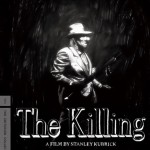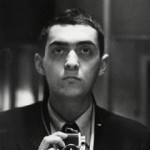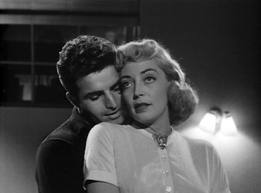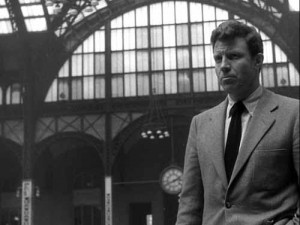The Killing/1956/United Artists/85 min.
 A DVD copy of “The Killing” from Criterion is this month’s Film Noir Blonde reader giveaway. Newly digitally restored, the two-disc set contains many extras, including Kubrick’s 1955 noir, “Killer’s Kiss,” also reviewed below.
A DVD copy of “The Killing” from Criterion is this month’s Film Noir Blonde reader giveaway. Newly digitally restored, the two-disc set contains many extras, including Kubrick’s 1955 noir, “Killer’s Kiss,” also reviewed below.
By Michael Wilmington
It takes guts and brains to pull the perfect heist. Or to shoot the perfect heist movie.
In 1956, at the age of 28, Stanley Kubrick, a New Yorker who grew up in the Bronx, traveled to Hollywood and San Francisco to direct the movie that would not only make his reputation but would provide the template – the clockwork nightmare with humans caught in the machinery – that defines most of the films he made from then on.
Those later films include acknowledged masterpieces: “Paths of Glory” (1957), “Dr. Strangelove, or How I Learned to Stop Worrying and Love the Bomb” (1964), “2001: a Space Odyssey” (1968), “A Clockwork Orange” (1971). But none of them is more brilliantly designed or more perfectly executed than that inexpensive film, “The Killing.”
Kubrick and nonpareil pulp novelist Jim Thompson (“The Killer Inside Me”) wrote the script, based on Lionel White’s neatly plotted crime novel “Clean Break.” The great cinematographer Lucien Ballard (“The Rise and Fall of Legs Diamond”) photographed the film.
That cast – a Who’s Who of noir types – includes Sterling Hayden (“The Asphalt Jungle”), Coleen Gray (“Kiss of Death”), Elisha Cook, Jr. (“The Maltese Falcon”), Marie Windsor (“The Narrow Margin”), Ted De Corsia (“The Naked City”), Timothy Carey (“Crime Wave”), James Edwards (“The Phenix City Story”), Joe Sawyer (“Deadline at Dawn”), Vince Edwards (“Murder by Contract”), Jay Adler (“Sweet Smell of Success”) and Jay C. Flippen (“They Live By Night”).
Perhaps inspired by Akira Kurosawa’s 1950 art-house classic “Rashomon,” Kubrick’s movie repeatedly circles back to the fictional Lansdowne race track (actually the Bay Meadows in San Francisco) during a fictional race. It’s a “jumbled jigsaw puzzle,” as one character calls it, that will supposedly end with a $2 million score of Lansdowne’s Saturday gambling receipts.
Immaculately orchestrated by a brusque criminal mastermind named Johnny Clay (Hayden), the heist kicks off when crack rifleman Nikki Arcane (Carey), shoots the favorite, Red Lightning, from a parking lot outside the track, at one of the turns. Thanks to Johnny, the robbery has been cleverly designed and planned to the last detail with each of the participants keenly aware of his part, executing it with precision and together getting away with the cash.
But like almost all great movie heists, like the robberies in “Rififi” and “The Asphalt Jungle” and “Le Cercle Rouge,” the one in “The Killing” has to unravel. And it does. The flaw in this system is the dysfunctional marriage between mousy cashier George (Cook, Jr., in his archetypal role) and George’s lazily sexy, unfaithful wife Sherry (Windsor, in hers).
George, desperate to keep his wayward wife interested, hints at an upcoming windfall. Sherry shares the leak with loverboy Val Cannon (Vince Edwards) – that has to be one of the great adulterous boyfriend movie names – and we can feel doom coming up fast on the outside.
The show clicked. It conquered audiences, especially critics. “The Killing” was immediately hailed by many as a classic of its kind, the very model of a high-style, low-budget thriller. “Kubrick is a giant,” said Orson Welles and it was the young Welles, of “Citizen Kane,” to whom the young Kubrick was most often compared.
If anything, his third feature’s reputation has grown over the years, as has the stature of the type of movie it embodies: the lean, swift, shadowy, cynical, hard-boiled crime genre we call film noir.
Also includes: “Killer’s Kiss”/1955/United Artists/67 min. This was Kubrick’s second feature and his first collaboration with producer James Harris. One of the most gorgeous-looking B movies ever, Kubrick shot in a style that effortlessly mixes the street-scene poetic realism of movies like “Little Fugitive” and “On the Waterfront” with film noir expressionism.
But Kubrick’s script is subpar, mostly in the dialogue. It creaks, while his cinematography soars. A nearly washed-up boxer (Jamie Smith) falls in love with the woman across the courtyard (Irene Kane, aka Chris Chase), a dance hall girl who’s tyrannized by her obsessively smitten gangster boss (Frank Silvera).
The story sounds trite and that’s how it plays. But Silvera is good and the classy visuals give “Killer’s Kiss” a power that holds you. All Kubrick needed was a writer and a cast, and in “The Killing,” he got them.
Stanley Kubrick photo from Vanity Fair, courtesy of the Look Magazine Photograph Collection/The Library of Congress.













From FNB readers